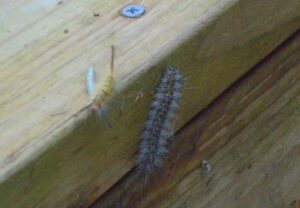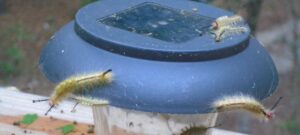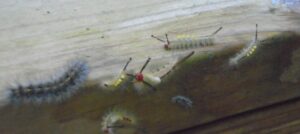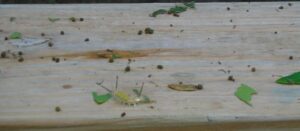Awareness is an interesting thing! Until something gets your attention or becomes a problem, you often times don’t even notice it. This was my experience with the fir tussock moth, (Orgyia detrita). I had never noticed it in the four years we had our property until caterpillars started raining out of the oaks onto our deck. Suddenly, we were invaded with hairy, tufted caterpillars!
Now caterpillars are not really a problem by themselves. Even these could be swept off the deck, the railings, the steps, the sides of the house and anywhere else you happened to look. The real problem was that the hairs on these creepy crawlies give you a bad rash and they also got all over the deck. I discovered this “after-effect” in the summer when we started painting and sealing the pressure-treated wood on our wrap-around deck. Most of the cocoons that the caterpillars wrap themselves in also have the same fuzziness that produces the rash.

The caterpillars start hatching in the oak trees as soon as it warms up here. They eat the oak leaves and when they get big enough, they make a jump line and fall out of the trees to find a place to cocoon. This year, we started seeing them at the beginning of March. The caterpillar invasion lasted a few weeks and it seemed like they were everywhere!
The fir tussock moth has two main colors: gray and yellow. We saw both of them crawling on the deck, on the stair railings, on the sides of the house, on the walls of the garage and in our garden! Every time I went out on the deck, I was sweeping caterpillars off these surfaces. Most of them are about an inch or two long. The reason they are called tussock moths is because of the hairs on their bodies that are grouped like a tussock or clump.
According to this article from the University of Florida, this kind of moth is found from Florida all the way north to Long Island and west to Texas along the Gulf of Mexico. Once they start falling out of the trees, the only way to get rid of them is to sweep them into a pail of soapy water or flatten them, but of course, the second solution is messier! If you do not kill them, they find a way to spin a hairy cocoon under the eaves of your house, in the trees, or on a wall that is relatively protected. Then they are harder to handle.


When I started painting the deck, part of my preparation was to take a metal spatula and scrape the cocoons off the wood. I am still finding them! Their favorite place is under the railings and those are hard to see unless you lean over the rail and look underneath.
When the moths hatch from the cocoons, the males are a splotchy gray-and-white color on their wings. Females have wings that are too short to use for flying so they just hang out at the cocoon and send out a chemical to attract males to their locations. Then they lay eggs on the cocoon and put more of those nasty hairs all over the eggs.
Luckily, the species we have here only does this once a year, usually from late February to early April. If we can get most of them off our house and the other places we are finding them, there may be less of a problem next year. The other solution is to spray the trees with a bacteria called Bacillus thuringiensis or Bt for short. When they eat oak leaves sprayed with Bt, it will kill them before they make the jump.

Fir tussock moths do have some natural enemies. Local birds will eat them, as will ground beetles and paper wasps. However, their biggest problems are the parasites of wasps and a virus that kills the caterpillars. I will be protecting the wasps on my property so they can help me reduce the moth population!
The Trials and Tribulations of Creating a Homestead – Part 3: Gutters, garage and workshop!

Wow! Invasion is right! Sounds like caterpillar management is going to be a yearly experience but perhaps something you can perfect overtime. Sounds like that “bt” stuff might be the right way to go if it doesn’t kill something you want. I looked it up and it won’t effect humans or livestock, so you’re safe there. I say go on the offensive!
We definitely got less caterpillars this year and for a shorter time. I don’t know how much the weather helped, but it was nice to get it over with quickly!